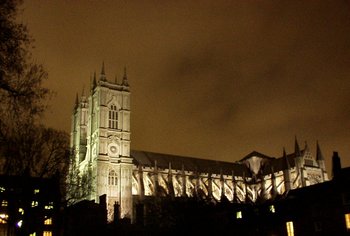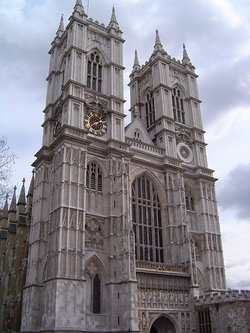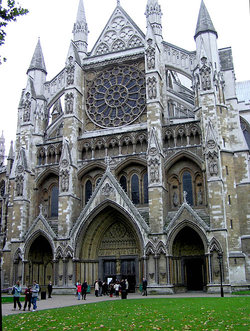Westminster Abbey
|
|
The Collegiate Church of St Peter, Westminster (Westminster Abbey), a mainly Gothic church, on the scale of a cathedral, is the traditional place of coronation and burial site for English monarchs. It is located in Westminster, London, just to the west of Westminster Palace. Template:Spoken Wikipedia
| Contents |
History
According to tradition, a shrine was first founded here in 616 on a site then known as Thorney Island. It was said to have been miraculously consecrated after a fisherman on the River Thames saw a vision of Saint Peter. While the existence of this shrine is uncertain, the historic Abbey was built by Edward the Confessor between 1045-1050 and was consecrated on December 28, 1065. Its construction originated in Edward's failure to keep a vow to go on a pilgrimage; the Pope suggested that he redeem himself by building an Abbey.
The original Abbey, in the Romanesque style that is called "Norman" in England, was built to house Benedictine monks. It was rebuilt in the Gothic style between 1245-1517. The first phase of the rebuilding was organised by Henry III, in Gothic style, as a shrine to honor Edward the Confessor and as a suitably regal setting for Henry's own tomb, under the highest Gothic nave in England. The work was largely finished by the architect Henry Yevele in the reign of King Richard II. Henry VII added a Perpendicular style chapel dedicated to the Virgin Mary in 1503 (known as the Henry VII Lady Chapel).
Although the Abbey was seized by Henry VIII during the Dissolution of the Monasteries in 1534, and closed in 1540, becoming a cathedral until 1550, its royal connections saved it from the destruction wrought on most other English abbeys. The expression "robbing Peter to pay Paul" may arise from this period when money meant for the Abbey, which was dedicated to St. Peter, was diverted to the treasury of St. Paul's Cathedral. It suffered damage during the turbulent 1640s, when it was attacked by Puritan iconoclasts, but was again protected by its close ties to the state during the Commonwealth period. Oliver Cromwell was given an elaborate funeral there in 1658, only to be disinterred in January 1661 and posthumously hanged from a nearby gibbet.
Westminster_Abbey_by_Canaletto,_1749.JPG
The Abbey was restored to the Benedictines under Queen Mary, but they were again ejected under Queen Elizabeth I in 1559. In 1579, Elizabeth re-established Westminster as a "royal peculiar" – a church responsible directly to the sovereign, rather than to a diocesan bishop – and made it the Collegiate Church of St. Peter, (i.e. a church with an attached chapter of canons, headed by a dean).
The abbey's two western towers were built between 1722 and 1745 by Sir Christopher Wren and Nicholas Hawksmoor, constructed from Portland stone to an early example of a Gothic Revival design. Further rebuilding and restoration occurred in the 19th century under Sir George Gilbert Scott.
Until the 19th century, Westminster was the third seat of learning in England, after Oxford and Cambridge. It was here that the first third of the King James Bible Old Testament and the last half of the New Testament were translated. The New English Bible was also put together here in the 20th century.
Coronations
Since the Christmas Day coronation of William the Conqueror in 1066, all English monarchs (except Lady Jane Grey, Edward V and Edward VIII, who did not have coronations) have been crowned in the Abbey. The Archbishop of Canterbury is the traditional cleric in the coronation ceremony. St. Edward's Chair, the throne on which British sovereigns are seated at the moment of coronation, is housed within the Abbey.

etc...
Burials and Memorials
Henry III rebuilt the Abbey in honour of the Royal Saint Edward the Confessor whose memorial and relics were placed in the Sanctuary. Henry III was buried nearby as were the Plantagenet kings of England, their wives and relatives. Subsequently, most Kings and Queens of England were buried here. Although Henry VIII and Charles I are buried at St. George's Chapel, Windsor Castle, as are all monarchs and royals since George II.
Aristocrats were buried in side chapels and monks and people associated with the Abbey were buried in the Cloisters and other areas. One of these was Geoffrey Chaucer, who was buried here as he had apartments in the Abbey as he was employed as master of the Kings Works. Other poets were buried around Chaucer in what became known as Poets' Corner. Abbey musicians such as Henry Purcell were also buried in their place of work. Subsequently it became an honour to be buried or memorialised here. The practice spread from aristocrats and poets to generals, admirals, politicians, scientists, doctors, etc., etc. These include:
Buried
Nave
- Clement Attlee, 1st Earl Attlee
- Angela Georgina Burdett-Coutts
- Charles Darwin
- James Clerk Maxwell
- J.J. Thompson
- Ben Jonson
- David Livingstone
- Sir Isaac Newton
- Ernest Rutherford, 1st Baron Rutherford
- William Thomson, 1st Baron Kelvin
- The Unknown Warrior
North Transept
South Transept
- Robert Adam
- Robert Browning
- William Camden
- Thomas Campbell
- Geoffrey Chaucer
- William Congreve
- Abraham Cowley
- William Davenant
- Charles Dickens
- John Dryden
- David Garrick
- John Gay
- George Frederick Handel
- Thomas Hardy
- Dr Samuel Johnson
- Rudyard Kipling
- Thomas Macaulay
- John Masefield
- Laurence Olivier, Baron Olivier
- Thomas Parr
Cloisters
North Choir Aisle
Commemorated
West-abb-standard.PNG
- William Shakespeare, buried Stratford-upon-Avon
- Sir Winston Churchill, buried Bladon, Oxfordshire
- Benjamin Disraeli, 1st Earl of Beaconsfield, buried Hughenden Manor, Buckinghamshire
- Adam Lindsay Gordon, buried Australia
- Paul Dirac, buried Florida
- Ten 20-century Christian martyrs from across the world are depicted in statues above the Great West Door. Unveiled in 1998, these are, from left to right:
Removed
The following were buried in the abbey but later removed on the orders of Charles II
Schools
Westminster School and Westminster Abbey Choir School are also on the grounds of the Abbey. Westminster School was originally founded by the Benedictine monks in 1179.
Transport
- Nearest London Underground stations:
- St. James's Park (District, Circle lines)
- Westminster (Jubilee, District, Circle lines)
List of Abbots, Deans, and the Bishop of Westminster
Westminster_Abbey_London_900px.jpg
See also
Further reading
- Simon Bradley & Nikolaus Pevsner: The Buildings of England - London 6: Westminster pp. 105-207. Yale University Press 2003. ISBN 0 300 09595 3.
External link
- Westminster Abbey (http://www.westminster-abbey.org/)da:Westminster Abbey
de:Westminster Abbey he:מנזר וסטמינסטר fr:Abbaye de Westminster it:abbazia di Westminster ja:ウェストミンスター寺院 nl:Westminster Abbey pl:Opactwo Westminsterskie pt:Abadia de Westminster ro:Catedrala Westminster sv:Westminster Abbey zh-cn:西敏寺


